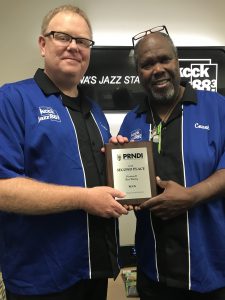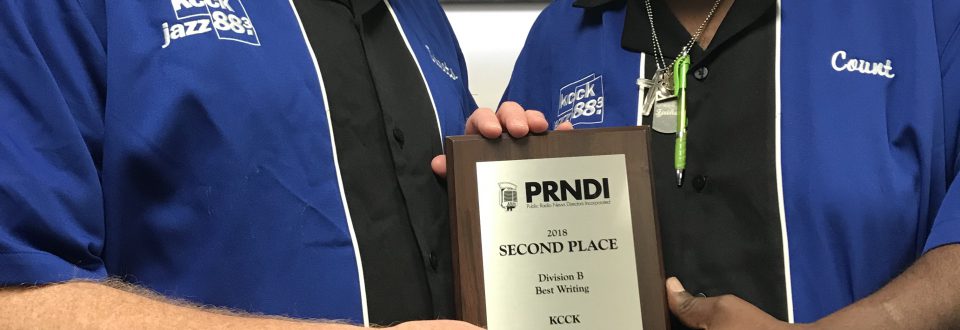
In 2018, Soundtrack to the Struggle won a Severeid Award from the Public Radio News Directors Association.
2021 marks KCCK’s fourth year airing Soundtrack to the Struggle, our on-going series celebrating jazz’s contributions to the fight for racial equality. We here at KCCK often say that, in jazz, every month is Black History month. The stories of jazz and Black America are inexorably joined, and those stories are endless. You can hear it all in the music – all the passion and pain and, yes, even joy.
KCCK’s Hollis Monroe and Ron Adkins produce new episodes each year; continuing to tell the story of how jazz prevails against inequity, violence, and systemic bigotry. Hollis and Ron agree that each new exploration opens their eyes and renews their commitment to the cause.
We asked Hollis, as a Black man who has traveled and performed across the country, and Ron, a White man born and raised in the Midwest, to talk about something they take away from their work on Soundtrack to the Struggle.
Hollis:
No art takes place in a vacuum.
Art reflects, informs and chronicles its time and place in history. When we set out to create “Soundtrack to the Struggle,” one of the most important questions we asked ourselves was, “Exactly what are we trying to accomplish here?”
What was our goal in creating this series? Was it to inform? To educate? To entertain? And, exactly, who was the audience at which this series was aimed?
The simple answers are, first: All of the Above.
We hoped that it would inform our listeners as to how this music was created by the crucible of events leading up to, and continuing through, the ongoing struggles encompassed by the Civil Rights Movement. We wanted to shine a spotlight on the famous, the infamous, the little known and the entirely forgotten figures in that struggle. And, of course, to do so in a way that would showcase the music and art created by these individuals during the course of their lives and careers.
Secondly, as to whom this series was aimed, again the answer is simple. Everyone.
We hoped that by offering these insights into the lives and struggles of those who helped shape and define jazz music that we provide a deeper understanding of what drove those artists who, in the face of bigotry and adversity, dared to create. Those who dared to cross the line. Those who fought within those boundaries and those who chose to create despite oppression.
In short, our audience for this series is anyone who appreciates a deeper understanding of jazz through understanding the courage, creativity and commitment of those who chose to live and make music, even in the face of segregation and, occasionally, horrendous abuse. We hope everyone gains a greater understanding of how these individuals, through their lives and music, influenced jazz and how artists continue to create change in our society and our world.
Ron:
All my life, I’ve wished to be colorblind. Growing up a White Iowan, that is a difficult wish to fulfill. The racial divide is often a study in sharp contrast.
I wish I could say that jazz makes me colorblind. But, since beginning my work with Soundtrack to the Struggle, I thankfully see the whole spectrum of jazz in the most vivid and unexpected ways. When listening, deeply listening, I see all the hues that Miles and Duke, Sweets and Cleanhead used to paint their masterpieces – all kinds of blues, greens like chimneys, reds like clouds of dust, black and tan fantasies.
In a perfect world, there should be no room for skin tones on that palate. But jazz has never been played in a perfect world. Not when a bomb explodes under “Fatha” Hines’s feet, or when Miles Davis is beaten by a cop on the streets of New York, or when Ella Fitzgerald is arrested for singing to a white audience. Or when any jazz musicians have to enter through the kitchen, or drive only roads deemed safe in the Green Book, or fear for their lives passing through a “sundown county.” That’s when Black and White are in sharp focus.
I study the stories of jazz, as a White man, and I become not just a better listener, but a better person. I hear, from my privileged balcony seat, what lies under the skin. Pain and anger and fear, but also great hope and unspeakable joy. And I see blood Reds, the Blues of a million tears, the dusty Browns of backroads, the radiant Yellows of love. In every note, there are anguished cries and jubilant hallelujahs. Beneath the skin, the soul is laid bare – the artists’ and my own.
Producing Soundtrack to the Struggle, I discovered that I must not close my eyes and ears to the contrasting Black and White. Both must be within the realm of my senses before I can hear the song being sung and the picture being painted.
